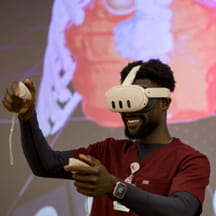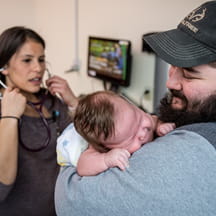Medical devices engineered for children’s size, growth, body chemistry, and disease propensity rarely leave the laboratory. A federal effort to funnel dollars to pediatric device consortia seeks to change that trend.
“Children are 25% of the population and 100% of the future, but while so meaningful, they are a relatively small percentage of medical patients,” said James Wall, MD, a pediatric surgeon at Stanford Medicine Children’s Health.
“If you look at publicly available data, there’s been really robust growth in FDA approvals of devices for adults with chronic diseases,” Wall said. “Fewer than five pediatric devices are approved by the FDA annually that are designed and tested for the unique needs of children. That’s been steady, and it hasn’t grown.”
Getting products to market
Wall serves as the principal investigator of the UCSF-Stanford Pediatric Device Consortium, one of five such nonprofit entities that receive Food and Drug Administration funding to support the development of pediatric-specific medical devices. The consortia provide:
- Regulatory expertise.
- Business planning guidance.
- Device development services, such as intellectual property advising, prototyping, engineering, laboratory testing, and grant writing.
They also hold competitive grant competitions to fund entities working to bring pediatric-focused products to market.
“A lot of physician entrepreneurs don’t understand the engineering business. A lot of business entrepreneurs don’t have access to patients or insights into health care. The consortia help them fill gaps through mentorship, coaching, and building development plans,” he said.
Challenges surrounding pediatric device development extend beyond the need for entrepreneurial acumen. Limited financial margins in pediatrics often present the biggest hurdle.
Wall referenced an effort at the Stanford Byers Center for Biodesign to create a device that reduced the risk of central line bloodstream infections in neonates by preventing umbilical venous catheters (UVC) from migrating. The domed design simultaneously ventilated the healing umbilicus and secured the UVC during baths, diaper changes, and procedures.
Investors weren’t interested. With a market of roughly 200,000 patients, the device had the potential to generate $20 million a year, Wall said. “To me, that sounds like a good amount of money. It doesn’t to venture capitalists. When you think about how you’re going to get an idea to the bedside, you have to think about the business side. It can’t cost you more to build these devices than you get paid for it.”
The biodesign team partnered with the UCSF-Stanford Pediatric Device Consortium to identify industry experts to donate time to the project as well as investors willing to take a risk. A modest financial investment allowed the team to conduct a clinical trial that showed a 70% reduction in catheter migration. The product was ultimately acquired by a med-tech company.
Federal funding for pediatric devices
The FDA grants funds to pediatric device consortia every five years and has awarded approximately $22 million since 2009. In 2023, five pediatric device consortia received funding, including the UCSF-Stanford group. Children’s hospitals and academic institutions lead the consortia. Associated advisory networks offer developers a chance to connect with experts in pertinent fields.
The newest group to receive funding is the Midwest Pediatric Device Consortium (MPDC) that includes Nationwide Children’s Hospital, Cleveland Clinic Children’s, Cincinnati Children’s, and The Ohio State University.
“It’s a big opportunity for the Midwest and a big opportunity for the institutions involved. It highlights the dense health care expertise in the region that we can leverage to help device companies across the country,” said Cory Criss, MD, a pediatric surgeon at Nationwide Children’s Hospital and co-principal investigator for the MPDC.
Despite the geographic separation, Criss said consortia leaders collaborate to exchange ideas, overcome barriers, and ultimately bring products that benefit kids to market.
“Within the medical device and digital health sphere, kids are truly an underrepresented population. The potential for return on investment is much different in pediatrics, so getting devices into the pediatric space takes a huge effort and a lot of strategy,” Criss said. “Collectively, the pediatric device consortia have acknowledged and accepted that challenge.”
Device examples
Consortia are supporting the development of products like these:
- Boppli, a non-invasive blood pressure monitoring device, helps some patients avoid arterial lines.
- Flowsense assesses hydrocephalus shunt function externally, eliminating the need for imaging studies.
- Biosense uses non-contact electrodes to prevent putting adhesive stickers on children during electrocardiograms.


